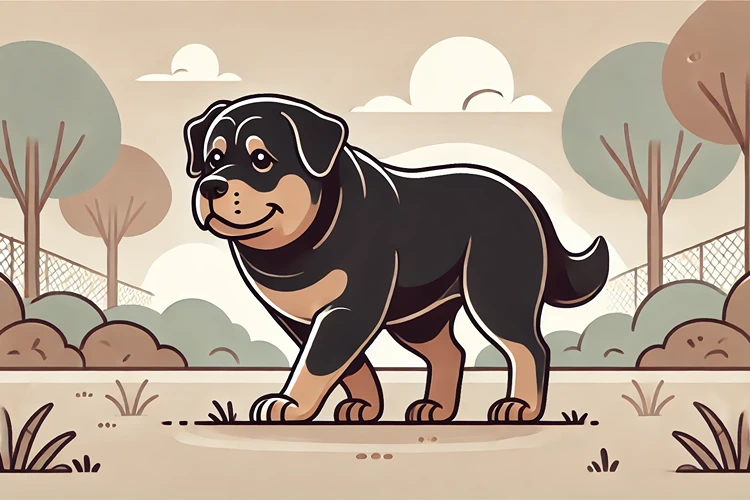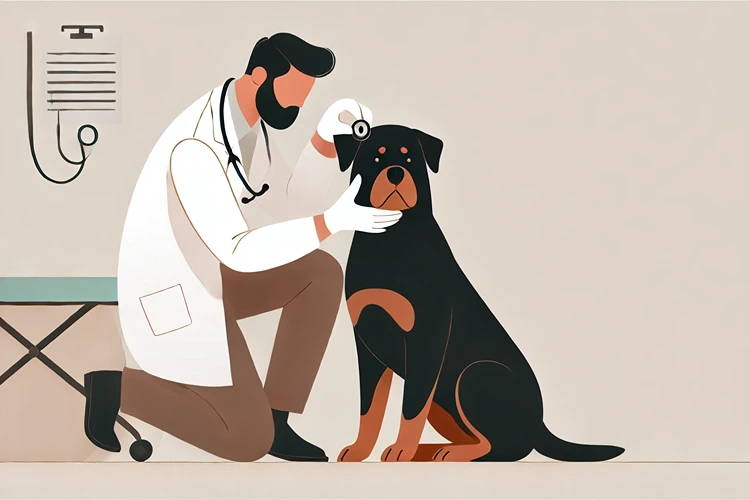As Rottweilers age, keeping them active can be a challenge, especially when their joints start to show signs of wear and tear. Senior Rottweilers are prone to joint issues, and while it’s important to keep them moving, we need to be mindful of the exercises we choose. Finding the best joint-friendly exercises for senior Rottweilers can make a big difference in their overall well-being, helping to keep them mobile, reduce pain, and even improve their mood.
In this article, we’ll explore the best exercises that will keep your senior Rottie active without putting too much strain on their aging joints.
What Are the Signs of Joint Problems in Senior Rottweilers?
Rottweilers are known for their strength and agility, but as they get older, their bodies start to slow down, and joint problems become more common. Recognizing the signs of joint discomfort early on can help you adjust their exercise routine accordingly. Here are some key indicators:
- Stiffness, especially after waking up or resting.
- Reluctance to jump, climb stairs, or play like they used to.
- Limping or favoring one leg over another.
- Swelling around joints.
- Unwillingness to walk for long periods.
If you notice any of these signs in your senior Rottie, it’s time to consider more joint-friendly exercises that will help maintain their strength without causing more discomfort.
Paw-some Tip:
Regular vet check-ups are key. If your Rottweiler is showing signs of joint discomfort, consult your vet before making any changes to their exercise routine.
What Are the Best Joint-Friendly Exercises for Senior Rottweilers?
Not all exercises are created equal when it comes to aging Rottweilers. High-impact activities can exacerbate joint problems, so it’s important to choose exercises that promote mobility without stressing their joints. Below are some excellent options for keeping your senior Rottie active while being kind to their joints.
1. Swimming: The Ultimate Low-Impact Exercise
Swimming is often touted as one of the best exercises for senior dogs, and for good reason. It’s a full-body workout that doesn’t put stress on the joints. The buoyancy of the water supports your Rottweiler’s weight, allowing them to move more freely. This makes swimming an ideal exercise for dogs suffering from arthritis or hip dysplasia.
Rottie Stats:
According to a 2019 study by the American Kennel Club, dogs that swim regularly are 30% less likely to suffer from severe joint pain compared to those that don’t engage in water-based activities.
2. Short, Gentle Walks: A Classic for a Reason
Walking is one of the simplest ways to keep your senior Rottweiler moving, but it’s important to adjust the intensity and duration. Long walks or hikes can be too much for aging joints, but short, gentle walks are perfect for keeping your dog active without causing strain. Aim for multiple short walks throughout the day rather than one long one.
3. Controlled Play with Soft Toys
Interactive play is still important for your senior Rottie, but be mindful of how hard they’re playing. Avoid games that involve jumping or sudden bursts of energy. Instead, focus on low-impact games that involve controlled movements, such as gently tugging on soft toys or slow games of fetch.
Paw-some Tip:
Instead of using hard toys, opt for soft, plush toys that are easier on your Rottweiler’s teeth and joints. You can even hide treats inside to make playtime more engaging!
How Often Should You Exercise a Senior Rottweiler?
Finding the right balance in how often you exercise your senior Rottweiler is key to maintaining their health without overworking their joints. Over-exercising can lead to increased joint pain, while too little exercise can make them stiff and less mobile.
A general guideline is 30 to 45 minutes of low-impact activity per day, broken up into shorter sessions if necessary. Every dog is different, so you may need to adjust based on your Rottie’s energy level and physical limitations.
Recommended Duration for Senior Rottweiler Exercises
| Exercise | Recommended Duration | Frequency |
|---|---|---|
| Swimming | 15–30 minutes | 2–3 times per week |
| Short Walks | 10–20 minutes | Daily |
| Controlled Play with Soft Toys | 10–15 minutes | Daily |
| Passive Range of Motion Exercises | 5–10 minutes | Daily |
| Slow Stair Climbing | 5–10 minutes | 1–2 times per week |
4. Passive Range of Motion (PROM) Exercises
PROM exercises involve gently moving your Rottweiler’s legs through their natural range of motion without them needing to put weight on the joints. These exercises can help improve flexibility, reduce stiffness, and increase circulation. They are especially useful for dogs that are less mobile due to arthritis or injury.
Here’s how to perform PROM exercises:
- Gently bend and extend each leg, holding the stretch for a few seconds.
- Keep the movement slow and controlled.
- Perform this on all legs for about 5 to 10 minutes daily.
Paw-some Tip:
Always start PROM exercises with your Rottweiler lying comfortably on their side. Be gentle and stop if they show any signs of discomfort.
5. Slow and Controlled Stair Climbing
While stairs can be a challenge for older Rottweilers, using them in a controlled manner can actually help strengthen leg muscles and support joint stability. However, it’s important to do this slowly and only if your dog is physically capable of climbing without pain. Instead of encouraging your senior Rottie to run up and down the stairs, guide them gently, offering support as needed.
Here are some tips for stair climbing exercises:
- Start with just a few steps at a time and gradually increase as your Rottweiler gets comfortable.
- Always supervise the activity to prevent injury.
- Use treats to encourage slow, steady movement, and avoid any sudden rushes up or down the stairs.
6. Balance Exercises on Soft Surfaces
Balancing on uneven or soft surfaces can help improve your Rottweiler’s coordination and stability, which is beneficial for their joints. You can use balance boards, soft cushions, or even grass to encourage your dog to shift their weight and use their muscles in a safe and controlled manner.
A simple balance exercise:
- Place your senior Rottweiler on a soft cushion or balance pad.
- Gently encourage them to shift their weight from side to side using a toy or treat.
- Keep sessions short (5–10 minutes) to avoid overexertion.
When to Adjust Your Rottweiler’s Exercise Routine
As much as we want to keep our senior Rottweilers active, it’s important to pay attention to their bodies and adjust their exercise routine as needed. Some days, they may be more energetic and ready for a longer walk, while other days they might show signs of stiffness and fatigue.
Here are a few signs that it’s time to scale back or adjust your Rottweiler’s exercise routine:
- Increased limping after exercise.
- Refusal to get up for a walk or playtime.
- Heavy panting or struggling to keep up during walks.
- Swollen or warm joints after activity.
If you notice any of these signs, give your Rottie a rest day or switch to a lighter activity like swimming or passive range of motion exercises. Regular communication with your vet will help ensure your dog’s exercise routine is appropriate for their age and condition.
7. Gentle Massage to Support Joint Health
While not technically an “exercise,” massage can be incredibly beneficial for senior Rottweilers with joint problems. Massaging your dog’s muscles and joints can help increase blood flow, reduce stiffness, and promote relaxation, which is especially important for dogs with arthritis or joint pain.
Massage tips for senior Rottweilers:
- Use gentle, circular motions on the larger muscles around their joints.
- Avoid putting direct pressure on sore joints.
- Start with short massage sessions (5–10 minutes) and gradually increase the time as your dog becomes more comfortable.
Paw-some Tip:
Use a dog-friendly massage oil or balm to make the experience more soothing for your Rottweiler. Always check with your vet before using any products to ensure they’re safe for your dog’s skin and joints.
Diet and Supplements to Support Joint Health in Senior Rottweilers
Exercise is only one part of the equation when it comes to joint health. A balanced diet rich in joint-supporting nutrients is equally important. Adding the right supplements to your senior Rottweiler’s diet can make a big difference in their mobility and comfort.
Key Supplements for Joint Health
Some of the best supplements to support your Rottweiler’s joint health include:
- Glucosamine and Chondroitin: These help maintain healthy cartilage and reduce inflammation in joints.
- Omega-3 Fatty Acids: Found in fish oil, these help reduce inflammation and support overall joint function.
- MSM (Methylsulfonylmethane): This compound supports joint health and reduces pain in arthritic dogs.
Rottie Stats:
Studies show that dogs on a diet supplemented with glucosamine and chondroitin saw a 20% improvement in mobility after just three months.
Foods to Include in Your Senior Rottweiler’s Diet
In addition to supplements, certain foods can support joint health by providing essential vitamins and nutrients. Here are some joint-friendly food options:
- Bone broth: Rich in collagen, it helps maintain healthy joints and cartilage.
- Sweet potatoes: High in antioxidants and vitamins that reduce inflammation.
- Salmon or other fatty fish: Provides Omega-3 fatty acids to reduce joint inflammation.
FAQs
Wrapping Up
Caring for a senior Rottweiler requires a thoughtful approach, especially when it comes to keeping them active and mobile. Incorporating joint-friendly exercises like swimming, gentle walks, and passive range of motion exercises can help maintain their strength and flexibility without causing unnecessary pain. Remember to pay attention to your Rottie’s comfort level, adjusting their routine as needed, and supplementing their diet with nutrients that support joint health.




